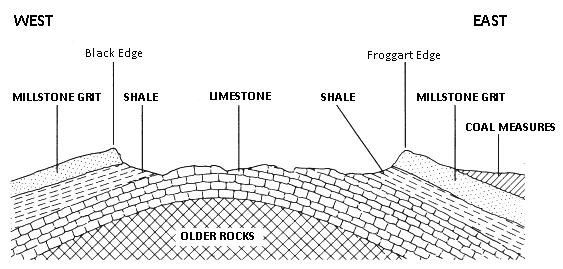The Derbyshire village that saw Britain's first oil boom
Tibshelf is not a famous place. I knew of it only as a service station on the M1, somewhere close to the Derbyshire-Nottinghamshire border.
 | |
| The car park at Tibshelf services. Exciting isn't it? (Photograph copyright William Metcalfe) |
It was something of a surprise, therefore, to learn that this pretty unassuming place actually has a major claim to fame:
 |
| Welcome to Tibshelf: home of the UK's first onshore oil well. |
Ever heard of the Derbyshire Oil Rush? No, me neither. Yet almost a hundred years ago, Tibshelf was identified as one of the most likely places in Britain to produce home-grown hydrocarbons, and, for almost three decades in the early 20th Century, it fulfilled that promise. It's really quite an intriguing little story, and to find out more you need to go a garden centre.
 |
| The Oilwell Nursery, Chesterfield Road, Tibshelf, Derbyshire. |
The name gives it away, but without that you'd have absolutely no idea this was a site of petroleum importance. The only reason I found out about it was thanks to being on a CeREES geological fieldtrip to the Derbyshire Dome. The trip aimed to show how the Peak District contains all the elements required for sourcing and trapping oil and gas, and then demonstrate it directly with a once-working well.
 |
| A simplified geological cross-section through the Peak District from west to east (from Wikipedia). |
The rocks are all of Carboniferous age, and divide up into four main types: limestone, shale, sandstone (Millstone Grit), and coals, as shown above. The Coal Measures have long been exploited for their value as a fuel, but the search for petroleum only began in the early 20th Century.
In 1915, with the First World War underway, the government needed reliable energy sources. The Americans had been drilling for oil in Pennsylvania since the latter half of the 1800s, originally and most famously at Titusville. This led prospectors to start looking in other parts of the world, and eventually even Britain got in on the act.
 |
| A Pennsylvanian oilfield in the 1860s |
After initial survey work, three British coalfields were identified as places of petroleum potential: the Midland Valley of Scotland, which already yielded oil shale, North Staffordshire, and north-east Derbyshire. Now all they needed to do was start drilling.
British techniques were pretty out-of-date, though, so the technical know-how had to be brought in from the USA. A team of American geologists, drillers, and engineers came across the pond to lead the exploration, and at Tibshelf, they eventually had success. On the night of May 27th 1919, at a depth of 3070 feet, Hardstoft No. 1 struck oil. Within a fortnight, petroleum was flowing from the well at a a rate of about 6 barrels a day.
 |
| One of your 6 a day? A barrel in the Oilwell Nursery at Tibshelf. |
By 1921, though, controversy had also been struck. The Hardstoft well was on land owned by the Duke of Devonshire and there were arguments between him and the government over who the oil belonged to. Production continued, but in 1923 the Duke secured control of the well and, after paying the government for the costs they'd incurred installing the plant and rig, and allowing them to keep the revenues generated from the first few years, he became Britain's first oil baron.
Further wells were drilled, but no new oil was located. Hardstoft No. 2 struck gas, which was used to provide fuel and heating for the site, but the amount of oil being generated from the original well began to decline. In 1938, only 93 barrels were produced.
This might have been the end of the Tibshelf tale, but the Second World War intervened and the importance of domestic energy supplies once more came to the fore. A few more years of oil were required, and only in 1945 was the well finally abandoned. Hardstoft No. 1 had produced around 30,000 barrels of oil over 26 years.
Whilst the site was subsequently turned into a piggery and a rubbish dump, oil still seeped out of the well and continued to be collected. The well was capped and the plant demolished in 1952, and in 1977 it became the Oilwell Nursery. Go there now, like we did, and you can still see the old wellsite, where a small plaque explains its importance.
 |
| Hardstoft Well No. 1, Tibshelf, Derbyshire. |
You can also purchase a short but interesting history of the well in the garden centre, from which some of my information has been gleaned (an online version can be found here). And if you want to invest in your very own British petroleum, Tibshelf oil is still bubbling up, and the garden centre owners bottle it up in small vials for connoisseurs to enjoy.
Yes, I now have one on my mantelpiece.
 |
| Authentic black gold from the heart of the East Midlands. |
Additional geological information - it is estimated that only about 10% of the oil was ever extracted, so there's plenty more still below the ground. Tibshelf is now known to be the inaugural exploration site in the East Midlands Oil Province, which has yielded significant petroleum discoveries in Nottinghamshire, Lincolnshire and Leicestershire. The oil derives from Namurian marine shales, which are also of interest in the current shale gas exploration around Lancashire.
If you want to read more about the prospectivity of onshore hydrocarbon provinces in the UK, the Department of Energy and Climate Change produced a report in 2010.
Comments